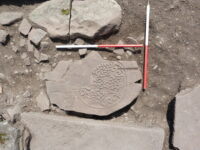 The remains of a Pictish carved stone cross slab with a rare inscription in the early medieval ogham language have been discovered in Old Kilmadock Kirkyard near Doune in Scotland. It is one of only 30 known ogham inscriptions found in all of Scotland, and the first discovered in the Forth Valley.
The remains of a Pictish carved stone cross slab with a rare inscription in the early medieval ogham language have been discovered in Old Kilmadock Kirkyard near Doune in Scotland. It is one of only 30 known ogham inscriptions found in all of Scotland, and the first discovered in the Forth Valley.
 The surface of the stone was first uncovered by volunteers from the Rescuers of Old Kilmadock (ROOK) in 2019, but it wasn’t until September of this year that volunteers and archaeologists were able to fully excavate the slab, exposing its edges and the ogham symbols. The stone is 47 inches high and 32 inches wide with a rounded top. The surface of the stone is carved with a knotted cross. The terminals of the enlaced scrolls are shaped like bird heads. They have sharply curved beaks like flamingos, but if they are representations of actual birds rather than stylized abstractions, they are probably pelicans in piety, popular symbols of Christ’s sacrifice.
The surface of the stone was first uncovered by volunteers from the Rescuers of Old Kilmadock (ROOK) in 2019, but it wasn’t until September of this year that volunteers and archaeologists were able to fully excavate the slab, exposing its edges and the ogham symbols. The stone is 47 inches high and 32 inches wide with a rounded top. The surface of the stone is carved with a knotted cross. The terminals of the enlaced scrolls are shaped like bird heads. They have sharply curved beaks like flamingos, but if they are representations of actual birds rather than stylized abstractions, they are probably pelicans in piety, popular symbols of Christ’s sacrifice.
Kilmadock is one of central Scotland’s oldest graveyards. It dates to the 9th century, but the Pictish cross slab predates the kirkyard. It was raised between 500 and 700 A.D. on a mound overlooking the Rover Teith. Archaeologists believe there was a monastery on the site at the time. The presence of ogham characters on the cross slab suggests the monks may have been literate.
Dr Kelly Kilpatrick, an historian and Celticist who specialises in epigraphy, will attempt to decipher the newly discovered inscription using photogrammetry to create a 3D model of the stone. She said: “It’s a hugely important find. It tells us that in the early medieval period there were literate people here who could read and write, potentially in Latin, but who were also familiar with the ogham alphabet.
“As soon as it was found I took one look and said ‘that’s ogham’. The inscription is likely to go all the way around, although I can’t be certain until the stone is lifted. They tend to say personal names. I can say with reasonable confidence we’ve got some e’s and t’s in there.”
ROOK has started a fundraiser with a goal of £5,000 for the conservation of the stone. It has to be raised before experts can even begin to translate the inscription, for one thing. The slab is fragile with heavy fragmentation of the carved surface requires specialist care to remove it from the kirkyard, clean it, dry it and sterilize it to kill all plant/moss/root material before puzzling the fragments back together. Click here to donate to the cause.